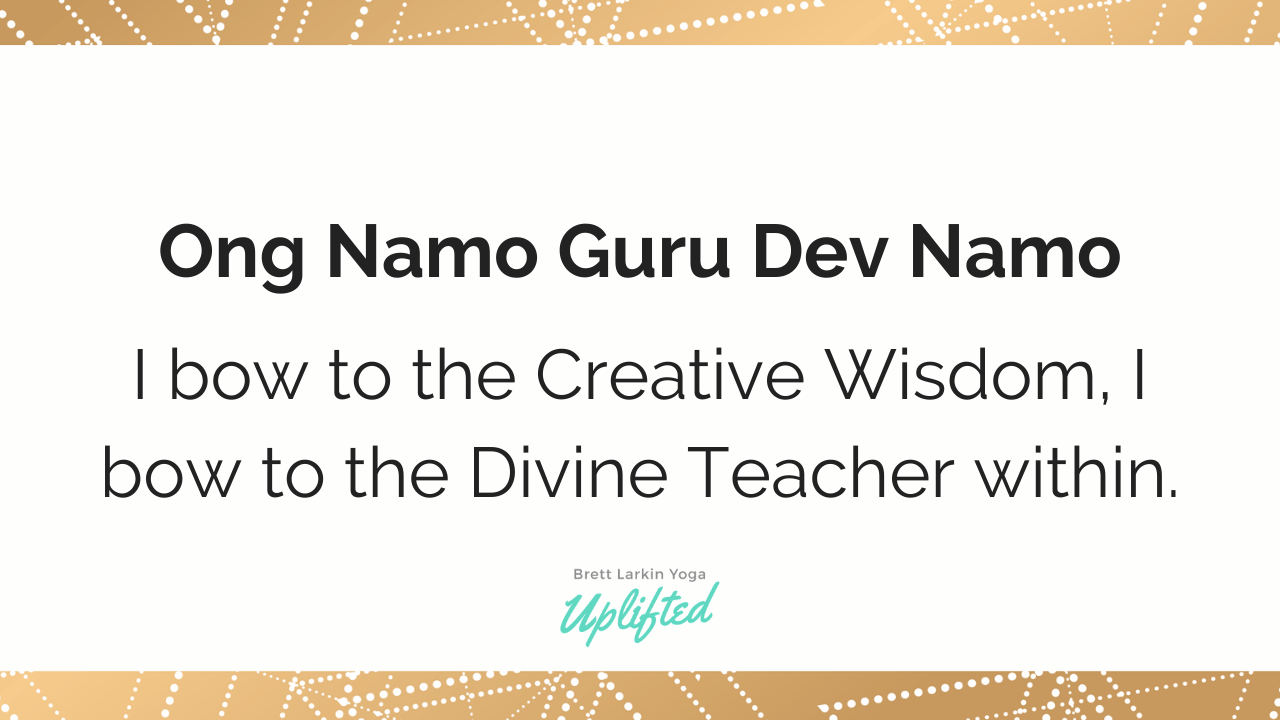Whether you’re just beginning your Kundalini yoga practice or you’ve been a Kundalini practitioner for many years, you’ll notice that every class begins by chanting the Adi mantra, ong namo guru dev namo.
It’s an incredibly powerful mantra that helps us connect with and refine the divine flow of infinite creative energy, both in ourselves and the reality around us.
But I was doing Kundalini Yoga for years before anyone ever really explained what this meant or how to do it properly!
So I want to break it down for you here so that you know exactly what you’re chanting the Adi mantra at the beginning of each Kundalini yoga session.
What is the Adi Mantra?
The Adi Mantra sets the tone for your yoga practice. It’s like a mantra meditation that connects the mind, body, and spirit as one. It is this state of connectedness that we recognize as Divine Truth, self-knowledge, higher consciousness, or WHATEVER term that describes meditative bliss.
In yoga, mantras hold sacred meaning. They are sort of like a primal vibration, at the very core of our existence.
Think about it.
Everything in this world has a vibration. Energy itself is a sort of vibration and we can see it (and measure) it even at the atomic level. Atoms buzz and swirl so fast that our eyes perceive them as solid matter when, in fact, they are just tiny buzzing particles.
And sound vibrates too. Sound is not something that you can hold with your hand but when you push air forcefully enough, it moves in a rhythmic pattern that our ears hear as sound.
The rhythmic pattern is a vibration that matches the same rhythmic patterns of the mantras. A primal vibration.
And when we begin our practice by chanting the complete Adi Mantra three times, we are quite literally tuning in like a tuning fork to the primal vibration of the infinite creative consciousness that drives all of existence.
What is the meaning of Ong Namo Guru Dev Namo?

The complete Adi mantra is ong namo guru dev namo and is used to tune in to higher consciousness at the beginning of every Kundalini yoga class.
When translated from Sanskrit, it means “I bow to the Creative Wisdom, I bow to the Divine Teacher within.”
I’m going to break down the mantra bit by bit so that you can truly tune in and allow the divine flow of energy to begin within you as you chant.
ONG
ONG means infinite creative energy and you want to say it, this is really important with the tongue hitting the roof of the mouth, the upper palate of the mouth. When you chant this sound, visualize energy at your third eye center.
Doing it in that way stimulates the hypothalamus, the pineal gland, and then the pituitary gland, which sit at the very center of your brain. From the outside of the body, you can most easily find it at the space right between and above your eyebrows, which is your third eye center.
And when you hold your tongue to the roof of your mouth as you pronounce the first syllable ONG, it’s going to activate pituitary gland, which is exactly what you want to do in Kundalini Yoga.
It’s also going to bring the energy towards the frontal brain. So the back of the brain is the more reptilian brain where we’re reactive and in survival mode. It’s a very emotion-based state of mind.
And in Kundalini Yoga you’re trying to raise your vibration. So by it chanting ONG correctly, striking the tongue at the top of the mouth, you’re pulling the energy forward into the front of the brain.
NAMO
NAMO, means I bow. The meaning has this reverence to it. When you’re chanting this word, you want to think of coming from Anahata Chakra, the fourth Chakra. So bring your attention to your heart center as you say, Na Mo.
If it’s hard for you to bring your attention to your heart chakra, visualize maybe light or radians coming from the heart center.
GURU
That third word, Guru, means remover of darkness. Gu means dark and ru means light. So guru is the remover of darkness.
Also, sometimes this is translated to mean the teacher, right?
But really, guru is anything that illuminates your vision, that takes you out of a space of darkness and helps you come into the light. In some cases, your guru can be your teacher, someone who teaches you how to connect with subtle divine wisdom.
In other cases, like with practicing Kundalini yoga, you can connect to the divine teacher within yourself through mantras, meditation, asana, hand mudras, pranayama, and more.
So as you’re saying Guru, allow the tongue to hit the roof of your mouth as you pronounce the R. It will sound more like ‘goodoo’ than ‘gooroo’ and will once again stimulate the pituitary gland.
DEV
And last word Dev means universal consciousness or divine wisdom, or you could even translate it as God. If you’re religious, it’s a higher power.
It’s an opportunity to approach divine consciousness or God or whomever with humility as you open yourself up to receiving wisdom and guidance in your practice.
NAMO
Then we repeat NAMO to bring us back into the heart center.
So bringing all these words together, there are so many different ways, interpretations that you can translate this. You could say this whole mantra taken together maybe means, I bow down to the universal wisdom, this higher power that exists within me and exists within all beings.
You could also think of it more as I honor the divine wisdom within myself that I am connected to a higher plane to that which made me.
Another translation I’ve heard that I really like is that I am making myself receptive. I am making myself a vehicle for higher consciousness, for infinite creative energy to come through me that also already exists within me. I am receptive to that and that’s a really nice translation when you put this in the context of the beginning of a class.
How do you chant Ong Namo Guru Dev Namo?

At the beginning of every single Kundalini Yoga class, you tune in with the Adi Mantra, Ong Namo Guru Dev Namo.
Before you begin, you rub your palms together and this is to awaken the 40,000 nadis, or nerve endings, in the palms.
And this also symbolizes union, right? Bringing together the left and right hemisphere of the brain, parasympathetic and sympathetic nervous system, bringing together the head and the heart. So it’s like you’re reconciling all the different parts of yourself when you bring the palms together.
Lift your elbows so that your arms are actively engaged in this process, and press your thumbs into your sternum. Relax the shoulders and take a deep, grounding breath.
Then, as you are breathing slowly and deeply, you can begin the chant. Repeat the chant three times as you continue to breathe.
As you finish, draw the breath up into the body. Pull your pelvic floor away from the mat and pull the navel in. Suspend the breath a little bit right after you finish but without any strain. So only holding it as long as it’s comfortable for you.
Roll your eyes up into that third eye center and exhale. Relax and put your hands down in your lap.
Tuning in is so important because it signifies the beginning of our practice, helps us separate our yoga time from all the rest of the time that’s busy throughout our day. It also connects us to the golden chain, or the lineage of yoga teachers and yoga students who have come before us.
Get 3 Free Training Vidoes from our Kundalini University Experience & Certification Program

YOU MIGHT ALSO LIKE
- Ek Ong Kar Sat Gur Prasad: Kundalini Mantra For Manifestation
- Tantric Har Chant: How It Fuels Prosperity and Inner Power
- Powerful Mantra for Protection Against Negative Energy and Harm
- The Power of Humee Hum Brahm Hum Mantra for Connection and Healing
- The Sa Re Sa Sa Mantra: Connecting Breath, Light, and Creativity
- What Is The Ajai Alai Mantra In Kundalini Yoga?
- What Is Sat Nam Rasayan? How And When To Practice
- The Meaning Of Ang Sang Wahe Guru Mantra in Kundalini Yoga
- Kundalini Yoga: How To Start A 40 Day Kriya
- Energetic Cord Cutting Ritual For Divine Feminine Energy
- The Ancient Art of Dhauti Kriya in Yoga: Cleansing and Purification
- What Is The Subtle Body? Yoga’s 9th Body
- Nauli Kriya: How To Practice This Cleansing Shatkarma
- Vasti Kriya: 3 Yogic Intestinal Cleanses
- How to Resolve Kundalini Awakening
Get 3 Free Training Vidoes from our Kundalini University Experience & Certification Program









